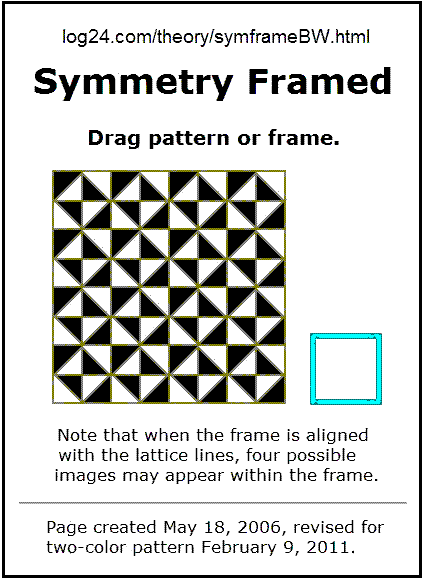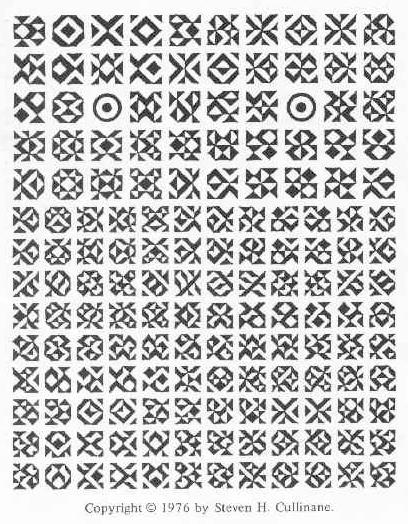See as well this journal on the above Heaven date — 18 November 2022.
Friday, December 1, 2023
“Principles Before Personalities” — AA Saying
Wednesday, October 28, 2015
The Tummelplatz of Jerusalem
A check of recent tweets by Alexander Bogomolny, who was
mentioned in the previous post, yields a remark of Oct. 26, 2015…
This is not unrelated to a word from Freud:
See as well "Digging Out the Truth?" (Jerusalem Post 2/25/2010)
and Michener's The Source in this journal.
Symmetry Framed
The cover of the K. O. Friedrichs book From Pythagoras to Einstein
shown in the previous post suggests a review (click the Log24
images for webpages where they can be manipulated) ….
The "more sophisticated" link in the first image above
leads to a webpage by Alexander Bogomolny,
"Pythagoras' Theorem by Tessellation," that says
"This is a subtle and beautiful proof."
Bogomolny refers us to the Friedrichs book, from which one of
the illustrations of the proof by tessellation is as follows —

For a quite different use of superposition, see
The Lindbergh Manifesto (May 19, 2015).
Thursday, January 24, 2013
Under Covers
For Amy Adams and Trudie Styler:
Click each cover for some background. See also…
Wednesday, February 9, 2011
An Abstract Window
The sliding window in blue below
Click for the web page shown.
is an example of a more general concept.
Such a sliding window,* if one-dimensional of length n , can be applied to a sequence of 0's and 1's to yield a sequence of n-dimensional vectors. For example— an "m-sequence" (where the "m" stands for "maximum length") of length 63 can be scanned by a length-6 sliding window to yield all possible 6-dimensional binary vectors except (0,0,0,0,0,0).
For details, see A Galois Field—

The image is from Bert Jagers at his page on the Galois field GF(64) that he links to as "A Field of Honor."
For a discussion of the m-sequence shown in circular form above, see Jagers's "Pseudo-Random Sequences from GF(64)." Here is a noncircular version of the length-63 m-sequence described by Jagers (with length scale below)—
100000100001100010100111101000111001001011011101100110101011111
123456789012345678901234567890123456789012345678901234567890123
This m-sequence may be viewed as a condensed version of 63 of the 64 I Ching hexagrams. (See related material in this journal.)
For a more literary approach to the window concept, see The Seventh Symbol (scroll down after clicking).
* Moving windows also appear (in a different way) In image processing, as convolution kernels .
An Abstract Power
Two characters named “Black” and “White” debate religion and the afterlife in the Cormac McCarthy play “The Sunset Limited.”
The play opened in Chicago in a Steppenwolf Theatre production on May 18, 2006.
A New York Times theater review from All Hallows’ Eve, 2006—
“…there is an abstract power in the mysteriousness of Mr. McCarthy’s
vision’s allowing for a multitude of interpretations.” –Jason Zinoman
The current New Yorker (Feb.14) has a note
by Lillian Ross on the same play— “Two-Man Show: O Death”
Some purely visual black-and-white variations that are less dramatic, but have their own “abstract power”—
A book cover pictured here last November to contrast with
“the sound and fury of the rarified Manhattan art world”—

and a web page with multiple interpretations of the book cover’s pattern—
A synchronicity— The first version of “Symmetry Framed” was done
on May 18, 2006— the day “The Sunset Limited” opened.
Another synchronicity relates the mathematics underlying
such patterns to the Halloween date of the above review.
See “To Announce a Faith,” from October 31, 2006.
Saturday, June 21, 2008
Saturday June 21, 2008
(See Eight is a Gate and
Faith, Doubt, Art, and
The New Yorker.)
A sructure from
today's previous entry:
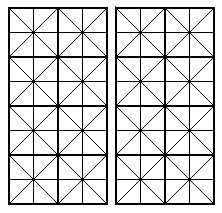
|
Everyone comes to Rick's.
Wednesday, July 25, 2007
Wednesday July 25, 2007
George Tabori
Filed with The New York Times
at 11:16 p.m. ET July 24, 2007–
George Tabori
“BERLIN (AP) — Hungarian-born playwright and director George Tabori, a legend in Germany’s postwar theater world whose avant-garde works confronted anti-Semitism, died Monday [July 23, 2007]. He was 93.
Tabori, who as recently as three years ago dreamed of returning to stage to play the title role in Shakespeare’s ‘King Lear,’ died in his apartment near the theater, the Berliner Ensemble said Tuesday, noting that friends and family had accompanied him through his final days. No cause of death was given.
Born into a Jewish family in Budapest on May 24, 1914, Tabori fled in 1936 to London, where he started working for the British Broadcasting Corp., and became a British citizen. His father, and other members of his family, were killed at Auschwitz.
Tabori moved to Hollywood in the 1950s, where he worked as a scriptwriter, most notably co-writing the script for Alfred Hitchcock’s 1953 film, ‘I Confess.’
He moved to Germany in the 1970s and launched a theater career that spanned from acting to directing to writing. He used sharp wit and humor in his plays to examine the relationship between Germany and the Jews, as well as attack anti-Semitism.
Among his best-known works are ‘Mein Kampf,’ set in the Viennese hostel where Adolf Hitler lived from 1910-1913, and the ‘Goldberg Variations,’ both dark farces that poke fun at the Nazis.”
From Year of Jewish Culture:
“The year 2006 marks the 100th anniversary of the establishment of the Jewish Museum in Prague.”
From the related page Programme (October-December):
“Divadlo v Dlouhé
George Tabori: GOLDBERGOVSKÉ VARIACE / THE GOLDBERG VARIATIONS, 19 October, 7 p.m. A comedy on creation and martyrdom.”
|
From Log24 on the date of 
The above is from Variable Resolution 4–k Meshes: Concepts and Applications (pdf), by Luiz Velho and Jonas Gomes. See also Symmetry Framed |
|
Theme (Plato, Meno)
 Click on “variations” above |
Thursday, October 19, 2006
Thursday October 19, 2006
(continued from Sept. 5):

Thanks to Peter Woit’s weblog
for a link to the above illustration.
This picture of
“Coxeter Exhuming Geometry”
suggests the following comparison:

For the second tombstone,
see this morning’s entry,
Birth, Death, and Symmetry.
Further details on the geometry
underlying the second tombstone:

The above is from
Variable Resolution 4–k Meshes:
Concepts and Applications (pdf),
by Luiz Velho and Jonas Gomes.
See also Symmetry Framed
and The Garden of Cyrus.
| “That corpse you planted last year in your garden, Has it begun to sprout? Will it bloom this year? Or has the sudden frost disturbed its bed?” — T. S. Eliot, “The Waste Land“ |
Thursday October 19, 2006
(Born Oct. 19, 1605,
died Oct. 19, 1682)
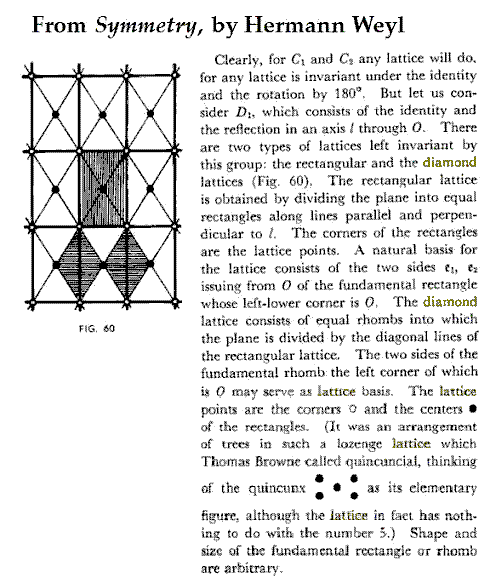
Browne is noted for
Hydriotaphia (Urne-Buriall)
and The Garden of Cyrus.
Related material:

Sunday, September 10, 2006
Sunday September 10, 2006
And the
"Meet Max Black"
Award goes to…
"For the Aeron and other designs,
Mr. Stumpf won this year’s
National Design Award
in Product Design,
which is to be presented
posthumously on Oct. 18
by the Cooper-Hewitt
National Design Museum
in Manhattan."
— Today's New York Times
Stumpf died on August 30,
the date of the Log24 entry
"The Seventh Symbol."
Related material:
From
Geometry of the I Ching,
a chessboard:

From the
National Design Museum:
From Log24 on the
date of Stumpf's death,
Pictorial version of
Hexagram 20,
Contemplation (View)
See also
Fearful Symmetry
and
Symmetry Framed.
Saturday, September 2, 2006
Saturday September 2, 2006
Salma Hayek
("Frida")

"Shinin' like a diamond
she had tombstones
in her eyes."

(For the above figures,
see Log24, 5/17/06,
"Tombstone," and
Log24, 9/13/03,
"For the Man in Black.")
and Keanu Reeves
("Constantine")
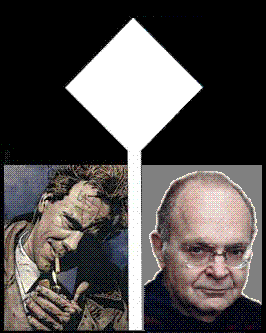
(For the above figure,
see Log24, 2/18/05,
"In Hoc Signo.")
Related material:
"Un cofre de gran riqueza
Hallaron dentro un pilar,
Dentro del, nuevas banderas
Con figuras de espantar."
"A coffer of great richness
In a pillar's heart they found,
Within it lay new banners,
With figures to astound."

For some further details, see
the brief Log24 narrative
"Indiana Jones and
the Hidden Coffer" as well as
Symmetry Framed and
the design of the doors
to Rick's Cafe Americain:








